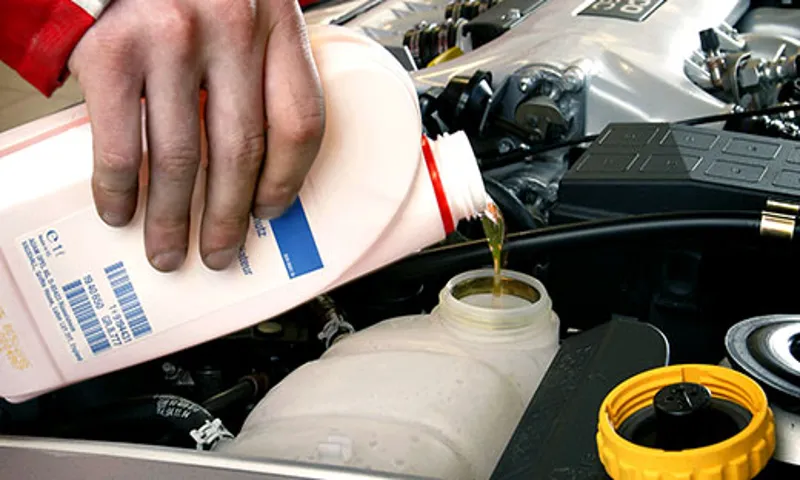Hey there, car enthusiasts! Today, I want to talk to you about something that might not always be on your mind, but is incredibly important for your vehicle’s overall health – the coolant. Now, you might be wondering, why is the coolant so important? Well, think of it as your car’s lifeline, keeping it cool and preventing it from overheating, especially during those scorching hot summer days or long drives. Imagine this – you’re driving on a hot summer day, windows down, enjoying the breeze, and suddenly, you notice the temperature gauge starts creeping up.
Your heart rate quickens as you frantically search for a safe spot to pull over. All because your car’s coolant has failed you. You see, the coolant, also known as antifreeze, plays a crucial role in maintaining your engine’s temperature.
It circulates through the engine, absorbing excess heat and then dissipating it through the radiator. Without it, your engine would quickly become a sizzling cauldron of metal, leading to potential damage and costly repairs. Think of the coolant as the James Bond of your car’s engine, undercover and always ready to save the day.
Just like Bond, it needs to be monitored and maintained regularly to ensure it stays cool under pressure. Regular coolant checks and flushes are essential to keep it in top-notch condition and avoid any potential overheating disasters on the road. So, the next time you’re taking your car for a spin, spare a thought for the unsung hero in the engine bay – the coolant.
By keeping your vehicle’s temperature under control, it allows you to enjoy smooth rides and peace of mind, knowing that you won’t be stuck on the side of the road with a steaming engine. Stay tuned for more tips and advice on how to take care of your car, and remember, cool cars have cool coolant!
Table of Contents
What is Coolant and Why is it Important?
In order to keep your car running smoothly, it’s important to understand the role of coolant and where to put it in your car. So, what exactly is coolant? Well, coolant is a liquid substance that helps regulate the temperature of your car’s engine. It’s usually a mixture of water and ethylene or propylene glycol, along with various additives to prevent corrosion and foaming.
Coolant is pumped through the engine to absorb heat and prevent it from overheating. It also helps in maintaining the optimal temperature for the engine to operate efficiently. When the engine runs, it generates a lot of heat due to the combustion process.
This heat needs to be dissipated to ensure that the engine doesn’t get too hot and cause damage. That’s where coolant comes in – it helps to transfer the heat away from the engine and dissipate it through the radiator. So, where do you put coolant in your car? Most cars have a coolant reservoir tank that is easily accessible under the hood.
It’s usually a translucent plastic tank with a “MAX” and “MIN” level indicator. The coolant reservoir tank is designed to allow for expansion and contraction of the coolant as the engine heats up and cools down. To add coolant, simply open the cap of the reservoir tank and pour the coolant mixture in until it reaches the “MAX” level.
Make sure to use the recommended type of coolant for your car, as specified in the owner’s manual. It’s also a good idea to check the coolant level periodically and top it up if needed, especially before long trips or during hot summer months. In summary, coolant plays a crucial role in maintaining the optimal temperature of your car’s engine.
By dissipating heat and preventing overheating, coolant helps to keep your engine running smoothly and reduces the risk of damage. So, next time you need to add coolant to your car, check the coolant reservoir tank under the hood and ensure that you use the recommended type of coolant. Your car will thank you for it!
Definition of Coolant
coolant, definition of coolant, importance of coolant, what is coolant

Importance of Coolant in Car Performance
coolant, car performance, importance of coolant, car engine, overheating, cooling system, antifreeze, radiator, lubrication, temperature control, liquid maintenance, preventing rust and corrosion, heat transfer, cooling efficiency, engine function. Coolant, also known as antifreeze, is a vital component for maintaining optimal car performance. It serves multiple purposes in the car engine, with its primary function being to prevent overheating.
The car’s cooling system relies on coolant to regulate the temperature and prevent the engine from reaching dangerous levels of heat. Just like how we need to stay cool during hot summer days, the car engine needs the same care. Imagine if you were to overheat after a long run and there was no way to cool down.
The same applies to your car’s engine. Coolant helps to maintain the engine’s temperature within a safe range, ensuring that all its components can function properly without any damage. It acts as a lubricant, reducing friction between moving parts and preventing wear and tear.
Additionally, coolant also plays a crucial role in preventing rust and corrosion within the engine. Over time, the liquid can deteriorate, losing its effectiveness in regulating temperature and preventing damage. That’s why it’s essential to regularly check and maintain the coolant level and quality.
By doing so, you can ensure that your car’s engine stays cool, efficient, and in top-notch condition. So, the next time you’re driving, remember the importance of coolant in keeping your car’s engine running smoothly.
Locating the Coolant Reservoir
So, you’re driving down the road and suddenly you notice that your car’s temperature gauge is rising higher than normal. What could be causing this? Well, one possibility is that your coolant level is low. But where do you even put the coolant in your car? Don’t worry, I’ve got you covered! The coolant reservoir is where you’ll find the perfect spot to add coolant to your car.
Usually, it’s located near the radiator and has a cap with a coolant symbol on it. Just pop open the cap, and carefully pour in the coolant until it reaches the appropriate level. It’s essential to use the correct type of coolant specified by your car’s manufacturer to ensure optimal performance.
So, next time your car’s temperature starts to climb, you’ll know exactly where to go – the coolant reservoir!
Step-by-Step Guide to Find the Coolant Reservoir
coolant reservoir
Different Types of Cars and Their Coolant Reservoir Locations
Coolant reservoirs are an essential component of any car’s cooling system, as they help regulate the temperature of the engine. However, finding the coolant reservoir in different types of cars can be a bit tricky. In most cars, the coolant reservoir is located near the front of the engine bay, next to the radiator.
It is usually a translucent plastic container with markings indicating the correct level of coolant. However, the exact location and design of the coolant reservoir can vary depending on the make and model of the car. For example, in some cars, the coolant reservoir may be located near the firewall, while in others, it may be hidden behind other components.
It’s always a good idea to consult the owner’s manual or do some online research to find out the specific location of the coolant reservoir in your car.
Adding Coolant to Your Car
If you’re having trouble keeping your car’s engine cool, you may need to add coolant. But where exactly does it go? Well, it’s not as complicated as you might think. Most cars have a coolant reservoir, which is typically a plastic tank located near the radiator.
You can usually find it by popping the hood and looking for a small container with a cap that says “coolant.” To add coolant to your car, first make sure the engine is cool. You don’t want to burn yourself! Then, simply unscrew the cap on the coolant reservoir and pour in the coolant.
Be sure to use the manufacturer-recommended type and mix it with water according to the instructions on the coolant bottle. Don’t pour the coolant directly into the radiator, as this can cause damage to your engine. Once you’ve added the coolant, replace the cap securely.
You’re all set! Just remember to check your coolant levels regularly and top up as needed. It’s important to keep your engine cool to avoid overheating and potential damage. So, next time you find yourself wondering where to put coolant in your car, just remember to look for the coolant reservoir and follow these simple steps.
Your car will thank you!
Precautions Before Adding Coolant
coolant, car, adding coolant, precautions before adding coolant, car maintenance
Step-by-Step Guide to Adding Coolant
coolant, adding coolant, coolant level, cooling system, engine temperature, overheating, radiator, expansion tank, reservoir, engine coolant, antifreeze, fluid level gauge, how to add coolant, step by step guide
Conclusion: Maintaining Optimal Coolant Levels
In conclusion, dear readers, the path to serenity and a well-cooled engine lies in the sacred realm of the coolant reservoir. Like a modern-day alchemist, you must pour this elixir into the depths of your car’s cooling system, where it will work its magic to keep your engine at the perfect temperature. Think of it as an enchanting potion, brewed with the finest ingredients to ward off the evils of overheating.
So, heed this advice, dear friends, and tend to your coolant reservoir with care, for it holds the power to keep your car from boiling over and leaving you stranded in a puff of steam. May your reservoir be forever full, your engine forever cool, and your adventures on the asphalt unforgettable. And remember, in the realm of automotive lore, the coolant reservoir is the knight in shining armor, keeping your chariot from turning into a fiery dragon.
Stay cool, stay classy, and keep that coolant flowing!”
Importance of Regularly Checking and Adding Coolant
coolant, regularly checking, importance, adding coolant, car
Benefits of Proper Coolant Maintenance
coolant maintenance, adding coolant, car coolant
FAQs
Where do I put coolant in my car?
The coolant reservoir is usually located near the engine. It may have a cap labeled “coolant” or “antifreeze.” Check your car’s manual for the specific location.
How often should I check the coolant level in my car?
It is recommended to check the coolant level in your car every month or before long trips. This will help ensure your engine remains adequately cooled.
Can I use water instead of coolant in my car?
Using water instead of coolant is not recommended. Coolant has additives that protect the engine against corrosion and freezing. Water alone does not offer the same level of protection.
How do I know if my car needs coolant?
If your car’s temperature gauge is consistently running hot or if you notice coolant leaks under your car, it may be a sign that your car needs more coolant.
Can I mix different brands of coolant?
You should avoid mixing different brands of coolant, as they may have different chemical compositions that could result in reduced effectiveness or potential damage to your engine.
How much coolant should I add to my car?
It is important to check your car’s manual for the recommended coolant capacity. Typically, the coolant reservoir should be filled to the “max” or “full” line.
Can I add coolant myself, or should I take my car to a professional?
Adding coolant to your car can typically be done by yourself. However, if you are unsure or uncomfortable, it is always a good idea to consult a professional mechanic to ensure it is done correctly.


